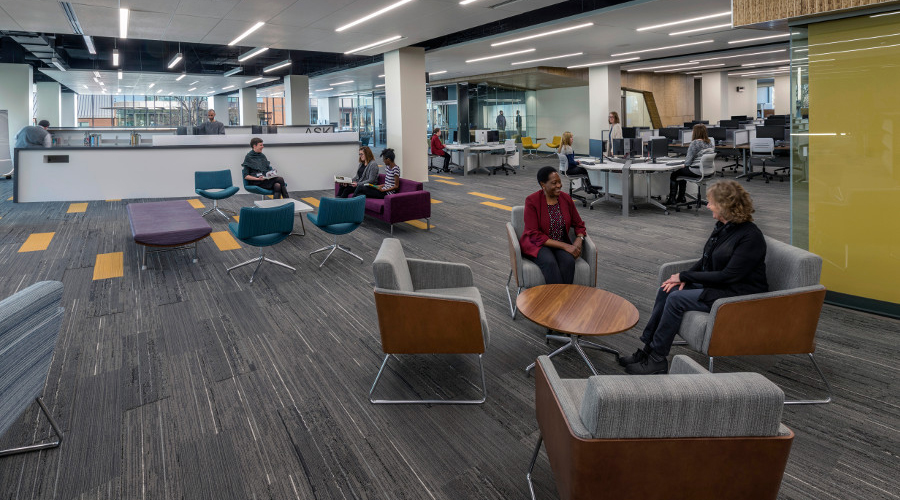- What's New
- Pricing & Purchasing
- Lead Times
- Literature & Samples
- Services & Warranties
- Careers
- Find a Rep
You Want Me to Work Where?

We’re entering a time of year that’s all too familiar for young adults across the country… back to college. I’m about to enter my second year at a large, public university and am wrapping up a three month internship at KI. My internship had me doing many different things but ultimately has given me a unique perspective on corporate culture and workplace environments, insights that are hard to learn in a classroom.
I’ve come to learn that there are stark differences between the expected work styles, physical spaces and environments on my college campus and the average corporate office.
KI is known for its expertise in education - higher education and K-12. Additionally, they work often with businesses across the country to create workplaces that appeal to the next generation of employees. KI is a firm believer that collegiate design is a driver for workplace design. Taking cues from institutions of higher education allows corporations to attract and retain recently grads.
One of my assignments during my internship was to survey KI’s interns to get a sense of their study habits, current learning styles and their expectations of employers as they enter the corporate world. The results were telling!
When analyzing the differences in how, why and where students work versus how, why and where we’re expected to work, it’s important to note where these expectations come from. They are created at school, often for the first time in our lives, giving us the ultimate flexibility in terms of where and how we work and study.
Rarely constricted to a single desk or workspace, my classmates and I enjoy a level of physical freedom that we were scarcely granted and will rarely find again. We no longer have to sit in a classroom from 8am to 4pm five days a week. We can study at any point and in any place throughout the day.
My typical day usually only involves about two or three hours of sit-down instruction, while the rest consists of unstructured and fully autonomous study time.
The expectations many students have about how we should go about our work are formed in these unstructured collegiate environments. Many of us will come to find that this is not how the traditional corporate world is structured. Students don’t want to be told where and when to work, because we’ve been able to widely work on our own terms for the past several years. Our expectations are grounded in the environments we’ve worked in for a majority of our 4+ years as college students, not in a typical office environment.
The fact of the matter is a college campus and a corporate office are very different, but there is a still an expectation that students suddenly and completely alter their style of work as new hires.
While college campuses are becoming increasingly adaptable to all work styles, workplace design is taking longer to address changing employee preferences. The employee recruitment conversation should no longer be one which excuses my generation as wide-eyed optimists, but rather about workplace design that takes cues from the places where we’ve just spent 4+ years preparing to work.
Take, for example, the idea of “personal and individual” workspaces. Traditionally, these kinds of spaces in the workplace would be cubicles or clearly divided desks. Workplaces were designed to be separated for the sake of quiet focus. However, “personal and individual” is now taking on a new meaning with a new generation of employees. While students still see these types of workplaces as areas of focus and minimal distraction, we see them through a lens that is grounded in flexibility and mobility.
In the survey I conducted to fellow interns, it was clear that these trends hold true.
For many young adults, flexibility means being able to work in multiple locations within a space throughout the day. Ninety-three percent of KI Interns noted that they study in at least 2 different places throughout the day when in school. Seventy-five percent of respondents said that their ability to be mobile within an office space was important to them.
Flexibility also means getting more out of one workspace. The reason students gravitate to traditionally collaborative areas (like libraries and cafes) is because they can be flexible with how they use the space.
While we still primarily prefer to work alone, these spaces (cited as popular for their large desktop spaces, whiteboards and non-crowded nature) have the ability to be used as coworking spaces when needed. The flexibility in a single space is a large attractor for students, and the quick and easy convenience of working alone to working with friends without moving is at the forefront of this new idea of flexibility.
Higher Ed has made great progress when it comes to campus design. Poorly lit, quiet library basements with individual workstations are becoming a thing of the past. Work and study spaces conducive to student work styles are now becoming the norm. My hope as someone who will enter the workforce in just a few short years is that corporations take notice as well.
It’s time that corporations change with the expectations and experiences of their emerging employees and this starts by looking at where they’re coming from.
If you’d like to learn more about the benefits of collegiate design in the workplace, check out KI’s white paper, “Collegiate Design: The New Driver for Workplace Design”.

Tyler Webb spent the summer of 2018 as a Marketing Communications Intern at KI. Tyler currently attends the University of Minnesota where he is majoring in Entrepreneurial Management and Marketing.
Subscribe
Stay up to date with the latest trends and more.



